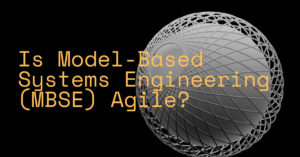
Systems engineering is a complex and challenging field, requiring collaboration and coordination among multiple stakeholders to design, develop, and deliver high-quality products.
In recent years, the Agile methodology has become widely adopted in complex hardware and systems development as a way to improve speed, quality, and customer satisfaction.
Model-Based Systems Engineering (MBSE) is a relatively new approach to systems engineering that has gained popularity in recent years.
So, the question arises: is MBSE an Agile methodology?
What is Model-Based Systems Engineering (MBSE)?
Model-Based Systems Engineering (MBSE) is an approach to systems engineering that uses models as a central artifact in the development process.
MBSE involves creating, using, and maintaining a comprehensive and consistent set of models to capture and communicate system requirements, design, and behavior.
The models are used to validate and verify system requirements, guide design and implementation, and support system testing and analysis.
MBSE supports iterative and incremental development, collaboration, and continuous improvement.
What is Agile methodology?
Agile is a flexible and adaptive approach to software and systems development that prioritizes customer satisfaction, collaboration, and continuous improvement.
Agile emphasizes delivering working software incrementally and iteratively, responding to change, and delivering value to the customer.
Agile teams use regular iterations and feedback loops to refine and improve their products, processes, and practices.
MBSE and Agile: Similarities and Differences
MBSE and Agile have many similarities, including a focus on collaboration, iterative and incremental development, and continuous improvement.
Both approaches value customer-centricity and prioritize delivering value to the customer. However, there are also differences between MBSE and Agile.
MBSE places a greater emphasis on using models to capture and communicate system information, whereas Agile prioritizes working software as the primary measure of progress.
Additionally, MBSE is more focused on systems engineering and the creation of high-level system models, while Agile is primarily focused on software development and delivering working software.
Advantages of using MBSE in an Agile environment
Despite the differences between MBSE and Agile, combining MBSE and Agile practices can lead to significant benefits for organizations.
By using MBSE in an Agile environment, organizations can improve collaboration and communication, as well as make faster and more efficient decisions.
Additionally, MBSE can help ensure that system requirements are better aligned with customer requirements, leading to higher levels of customer satisfaction.
So, is MBSE agile?
Model-Based Systems Engineering (MBSE) can be considered an Agile approach to systems engineering, as it shares many of the key principles and practices of the Agile methodology.
By using MBSE in an Agile environment, organizations can improve the speed, quality, and customer satisfaction of their systems engineering projects.
However, it’s important to recognize that MBSE and Agile are not identical and that organizations should carefully consider the unique characteristics and requirements of each approach to determine the best fit for their needs.
Use Valispace to do Agile Engineering
Valispace is a cloud-based solution for supporting Agile hardware development.
It enables teams to save and share designs, requirements, and system models and link them in real time. This can assist in ensuring that everyone is on the same page and aid in the early detection of faults and discrepancies.
For most hardware engineering projects that want to go agile, the most helpful unique feature relates to the ability to connect requirements to engineering data.
This feature allows teams to ensure that all requirements are linked to engineering values and that any numerical data can be read and analyzed as such, rather than as flat text data.
This means that if any changes are made to your system, Valispace can automatically calculate whether this violates any of your project requirements.
Less work for your engineers, smarter insights for your project managers, and happier customers that love your product.
Another critical aspect of Valispace is its support for various agile development techniques such as Scrum and Kanban. This implies that teams may select the method that best meets their needs and adapt and adjust as necessary.
Valispace also offers a variety of additional features and tools that can aid with Agile hardware development including:
- Version control
- Communication tools
- Reporting and analytics.
Valispace can assist teams in managing complexity, collaborating efficiently, and delivering a great product by providing a comprehensive collection of tools and functionalities.
If you’re interested in adopting Valispace for your Agile hardware development project, schedule a call with the Valispace team to discuss your unique requirements.

